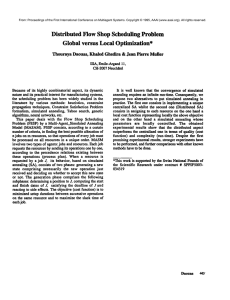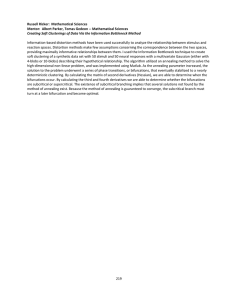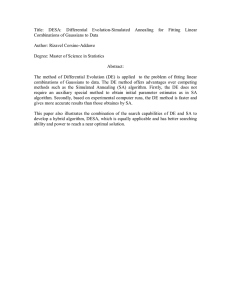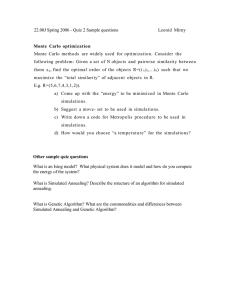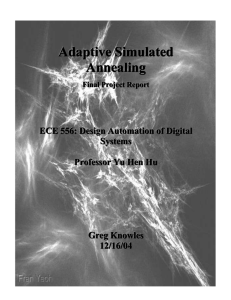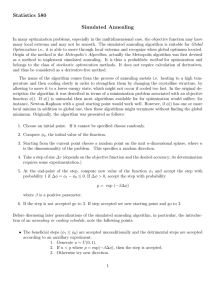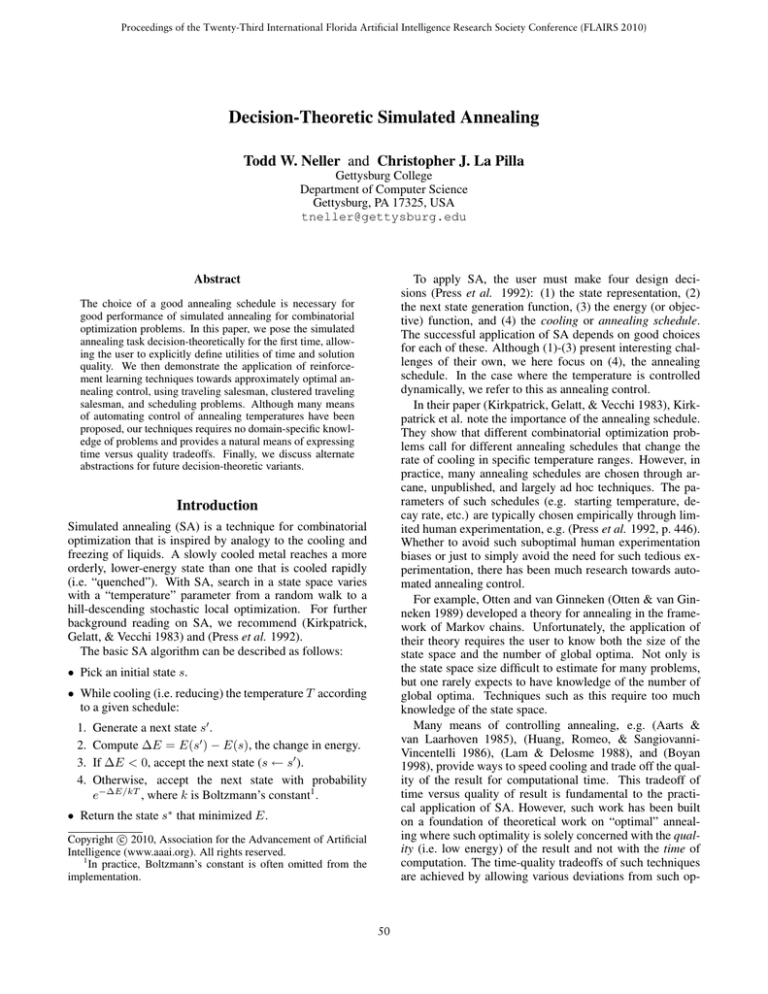
Proceedings of the Twenty-Third International Florida Artificial Intelligence Research Society Conference (FLAIRS 2010)
Decision-Theoretic Simulated Annealing
Todd W. Neller and Christopher J. La Pilla
Gettysburg College
Department of Computer Science
Gettysburg, PA 17325, USA
tneller@gettysburg.edu
To apply SA, the user must make four design decisions (Press et al. 1992): (1) the state representation, (2)
the next state generation function, (3) the energy (or objective) function, and (4) the cooling or annealing schedule.
The successful application of SA depends on good choices
for each of these. Although (1)-(3) present interesting challenges of their own, we here focus on (4), the annealing
schedule. In the case where the temperature is controlled
dynamically, we refer to this as annealing control.
In their paper (Kirkpatrick, Gelatt, & Vecchi 1983), Kirkpatrick et al. note the importance of the annealing schedule.
They show that different combinatorial optimization problems call for different annealing schedules that change the
rate of cooling in specific temperature ranges. However, in
practice, many annealing schedules are chosen through arcane, unpublished, and largely ad hoc techniques. The parameters of such schedules (e.g. starting temperature, decay rate, etc.) are typically chosen empirically through limited human experimentation, e.g. (Press et al. 1992, p. 446).
Whether to avoid such suboptimal human experimentation
biases or just to simply avoid the need for such tedious experimentation, there has been much research towards automated annealing control.
For example, Otten and van Ginneken (Otten & van Ginneken 1989) developed a theory for annealing in the framework of Markov chains. Unfortunately, the application of
their theory requires the user to know both the size of the
state space and the number of global optima. Not only is
the state space size difficult to estimate for many problems,
but one rarely expects to have knowledge of the number of
global optima. Techniques such as this require too much
knowledge of the state space.
Many means of controlling annealing, e.g. (Aarts &
van Laarhoven 1985), (Huang, Romeo, & SangiovanniVincentelli 1986), (Lam & Delosme 1988), and (Boyan
1998), provide ways to speed cooling and trade off the quality of the result for computational time. This tradeoff of
time versus quality of result is fundamental to the practical application of SA. However, such work has been built
on a foundation of theoretical work on “optimal” annealing where such optimality is solely concerned with the quality (i.e. low energy) of the result and not with the time of
computation. The time-quality tradeoffs of such techniques
are achieved by allowing various deviations from such op-
Abstract
The choice of a good annealing schedule is necessary for
good performance of simulated annealing for combinatorial
optimization problems. In this paper, we pose the simulated
annealing task decision-theoretically for the first time, allowing the user to explicitly define utilities of time and solution
quality. We then demonstrate the application of reinforcement learning techniques towards approximately optimal annealing control, using traveling salesman, clustered traveling
salesman, and scheduling problems. Although many means
of automating control of annealing temperatures have been
proposed, our techniques requires no domain-specific knowledge of problems and provides a natural means of expressing
time versus quality tradeoffs. Finally, we discuss alternate
abstractions for future decision-theoretic variants.
Introduction
Simulated annealing (SA) is a technique for combinatorial
optimization that is inspired by analogy to the cooling and
freezing of liquids. A slowly cooled metal reaches a more
orderly, lower-energy state than one that is cooled rapidly
(i.e. “quenched”). With SA, search in a state space varies
with a “temperature” parameter from a random walk to a
hill-descending stochastic local optimization. For further
background reading on SA, we recommend (Kirkpatrick,
Gelatt, & Vecchi 1983) and (Press et al. 1992).
The basic SA algorithm can be described as follows:
• Pick an initial state s.
• While cooling (i.e. reducing) the temperature T according
to a given schedule:
1.
2.
3.
4.
Generate a next state s .
Compute ΔE = E(s ) − E(s), the change in energy.
If ΔE < 0, accept the next state (s ← s ).
Otherwise, accept the next state with probability
e−ΔE/kT , where k is Boltzmann’s constant1 .
• Return the state s∗ that minimized E.
c 2010, Association for the Advancement of Artificial
Copyright Intelligence (www.aaai.org). All rights reserved.
1
In practice, Boltzmann’s constant is often omitted from the
implementation.
50
outputs so as to maximize the expected utility of the process. These sensory inputs may come at varying intervals
in the process, and consist of information about the process.
Control outputs dictate how the process should proceed until
the controller functions next.
In pursuing optimal control, the two primary considerations are (1) the utility of the quality of the result of SA (i.e.
the value of the state found), and (2) the utility of the time
taken to compute such a result. Put simply, each iteration of
simulated annealing offers a potential gain of solution quality with a definite loss of time.
The measure of result quality, called the objectlevel (Horvitz 1988) or intrinsic (Russell & Wefald 1991)
utility function, should be considered distinct from the state
energy function of SA. While object-level utility may be a
function of energy, the two functions serve different purposes. A result of SA may not have any object-level utility
until its energy crosses a certain threshold. The energy function, by contrast, can and should provide guidance in searching the state space. We denote the energy and object-level
utility of the search state s to be E(s) and UO (s) respectively.
We must also measure the utility of time. The time cost
or inference-related utility, denoted UI (t), represents the
cost of computation where t is elapsed SA time. Let st
be the current search state of an SA process at time t. Let
s∗t = argminst ,t ∈[0,t] E(st ) denote the minimal energy
state visited up to time t. Then the net utility U (s∗t , t) of
an SA process at time t is UO (s∗t ) − UI (t). If we compare
the net utility of an SA process at two different times t1 and
t2 , then the net utility of the SA process from t1 to t2 is
U (s∗t2 , t2 ) − U (s∗t1 , t1 ).
The annealing agent may choose between iterations how
to proceed with annealing. We call each of the annealing
agent control signals an annealing action. An annealing action may dictate a temperature control policy and the duration (i.e. number of iterations) of that policy. Another important annealing action is to terminate the SA process. An
annealing agent monitors the state of the SA process and directs its progress or termination.
Optimal control of annealing would then be an agent mapping annealing process information to annealing control actions that maximize expected utility. Thus, learning optimal control of annealing entails some form of search among
mappings from annealing states to annealing actions for one
that approximates optimal control. For this we apply policy evaluation and improvement techniques of reinforcement
learning (Sutton & Barto 1998).
timal annealing (e.g. deviations from thermal equilibrium).
To date, no method has dealt explicitly with the user’s utility
of time and quality, i.e. what is optimal to the user.
In this paper, we introduce a means of controlling annealing that requires no knowledge of the state space, and
allows the user to be explicit about the time-versus-quality
tradeoff. This is accomplished by first posing SA decisiontheoretically as an optimal control problem, and then applying simple reinforcement learning techniques (Sutton &
Barto 1998). Annealing control is learned through annealing
experience. Our experiments demonstrate the practicality
of this technique through successful application to traveling
salesman problems and course scheduling problems.
Related Work
Whereas we will discuss the application of machine learning to the design of annealing schedules, machine learning
has also been applied to the separate problems of initial state
selection and next state generation. In principle, these techniques could be used in conjunction with our own.
Boyan’s STAGE algorithm (Boyan & Moore 1998) is a
multi-restart stochastic local search algorithm that intelligently chooses initial states for restarts. Given that each
initial state and Markovian stochastic local search leads to
a final state with its associated object-level utility, STAGE
learns a function approximation for the mapping of initial
states to final state utilities, using both the given objective function and additional relevant weighted search features. STAGE then hill-climbs this function approximation
to choose the next initial state that is expected to maximize
the final state utility for the next stochastic local search.
In his master’s thesis (Su, Buntine, & Newton 1997), Su
is concerned with combinatorial optimization problems with
computationally expensive energy functions, e.g. the VLSI
cell-based layout placement problem. Su uses regression to
compute a function approximator that efficiently predicts the
energy of a state. With each iteration of annealing, many
possible next states are sampled and evaluated with this efficient approximator. The sampled neighboring state with the
minimal expected energy is chosen as the next state for the
iteration.
In the section “A Simple Parameter-Learning Agent”, we
refer to the agent task as parameter selection because of its
relation to work on the algorithm selection problem as defined in (Rice 1976). In particular, the work of (Lagoudakis
& Littman 2000) is closely related to our own in that reinforcement learning techniques are applied to the dynamic
recursive selection of algorithms for sorting and order statistic selection problems. In contrast, we learn control of an
algorithm parameter dynamically within an iterative architecture. Work in this area increasingly provides evidence
of the benefits of learning metalevel algorithm selection and
control.
Experiments and Observations
We describe two annealing agents; a parameter-learning
agent demonstrates that simple reinforcement learning techniques can be applied to existing annealing schedules to find
approximately optimal parameter settings, subject to a userdefined utility measure. We then describe a more complex
annealing control agent that demonstrates how reinforcement learning may be used to obtain problem-specific, adaptive annealing schedules.
Decision-Theoretic Simulated Annealing
A decision-theoretic controller for simulated annealing
maps sensory inputs and utility gains or losses to control
51
First, we present an overview of the annealing problems
used to evaluate our learning agents.
Annealing Problems
Three combinatorial optimization problems were used for
our experiments: the traveling salesman problem, the clustered traveling salesmen problem, and a scheduling problem. Both of the traveling salesmen problems and Lin and
Kernighan’s next state generation function are described in
(Kirkpatrick, Gelatt, & Vecchi 1983). In both cases, 400
cities were distributed on a 350-by-350 grid.
Each randomly generated instance of our simple coursescheduling problem consists of 2500 students, 500 courses,
and 12 time slots. Each student is enrolled in 5 unique random courses. Each state of the problem is represented as a
list containing the time slot for each course. Next states are
generated by randomly changing the time slot of one course.
The energy function E(s) is defined as the total number of
course conflicts, i.e. the total number of class pairs in each
student’s enrollment which occur in the same time slot.
For all of our tests, we define our measure of the objectlevel utility of a state UO (s) such that changes in energy at
low energy states are weighted more heavily than changes
at high energy states: UO (st ) = −log10 (E(st )). Our time
cost function UI (t) = ct, where c is a fixed cost per iteration
and t is the number of iterations completed. This allows us
to compare results generated on different machines.
In previous work (Neller & Hettlinger 2003), we have
shown that a preliminary version of a decision-theoretic annealing agent was capable of learning a rapid-cooling schedule, i.e. “simulated quenching”. For these experiments, we
wished to demonstrate learning of a non-extreme behavior which is neither quenching, nor close to thermal equilibrium. We found that for all problems, an iteration cost
c = 2.2 × 10−8 achieved this objective.
SA process
final net
utility
e−greedy
Q−learning
m
SA process with
m iteration
geometric
schedule
(a) Simple parameter-learning agent
SA process
net utility and
temperature
SARSA
learning
SA partial process
over temperature
subrange with
m iterations
m or
terminate
(b) Annealing control agent
A Simple Parameter-Learning Agent
In this section, we present a parameter-learning agent (Figure 1(a)) which is both simple to implement and aids in
understanding the more complex dynamic control agent of
the next section. Our agent treats an annealing schedule or
autonomous annealing controller as a black box with parameters. We assume a reasonable, finite set of parameter
choices A with |A| = n. The agent attempts to find the optimal parameter values through experimentation.2 There are
many different action selection approaches for balancing explorative versus exploitative actions (Sutton & Barto 1998).
Since our purpose is pedagogical, we will describe a simple
-greedy agent.3
SA process
state
information
reinforcement
learning
SA partial
process
annealing
control
action
(c) General DTSA agent
2
We can view this experimental task as an n-armed bandit
problem with conditional dependencies. Numerous studies, e.g.
(Horowitz 1973; Meyer & Shi 1995; Anderson 2001; Gans, Knox,
& Croson 2004), have shown that human experimentation on such
problems is suboptimal in predictable ways. This further reinforces
the usefulness of automated approaches.
3
Our softmax agent had faster convergence to optimal behavior, but this would require us to have two separate applications of
Boltzmann distributions with two temperature parameters.
Figure 1: Metalevel learning of annealing control
52
Our agent learns parameter selection over random representative sets of problems. Let Qt (a) be the average
decision-theoretic net utility of all complete trials at learning iteration t using parameter choice a ∈ A. When no
trials have been performed with a, we define Qt (a) = 0.
Each iteration of learning proceeds as follows. With
probability , we uniformly, randomly select a parameter
a ∈ A. Otherwise, we select the a having the highest expected net utility (i.e. the “greedy” action), that is, we select
argmaxa∈A Qt (a). We run the algorithm with the selected
a, and incrementally update our average Qt (a) with the experienced net utility.
Our simple -greedy agent used = .1. No effort was
made to tune in order to show that this metalevel control
did not itself need metalevel control.
For each annealing trial, the parameter to be selected is
m, the number of annealing iterations. Parameter set A consists of 9 choices for m, equally-spaced logarithmically between 105 and 107 (inclusive). The annealing schedule was
a simple geometric schedule, where α was computed to take
the temperature from a fixed T0 and Tm−1 in m iterations.
The starting temperature T0 was derived using the method
described in (White 1984; Huang, Romeo, & SangiovanniVincentelli 1986), where one performs random walks on initial states, computing the standard deviation σ of the ΔE’s.
Then, an initial temperature of T0 = 20σ is sufficiently
high to accept virtually all ΔE’s, and serves as a reasonable starting temperature. The final temperature was derived
similarly, such that any positive ΔE for a problem would
be almost certainly rejected. Starting and ending temperatures for the traveling salesman problems were 2 × 104 and
1 × 10−4 respectively; for the scheduling problem, starting
and ending temperatures were 1 × 103 and 1 × 10−3 respectively.
For each experiment, learning occurs over 16384 (214 )
simulated annealing trials with randomly generated instances of a given problem. After each trial that is a power
of 2, a greedy policy is logged based on the current Qt (a)
estimates. These policies were then later tested with a randomly generated benchmark set of 100 problems. All figures
show the tested utility means and 90% confidence intervals
from bootstrapping with 10000 resamples. The progress of
-greedy learning is shown in Figure 2.
In each case, we see that there is an initial period of experimentation after which the quality greatly increases to the
optimal setting. This jump occurred between 64 and 128
iterations for traveling salesman problems, and between 32
and 64 iterations for the scheduling problem. After the jump,
the policy changed slightly (except in the case of the clustered TSP) and fixed on the optimal selection for the remainder of trials, which is 106 iterations for the clustered TSP
and 5.6 × 105 for the other problems. Peak mean utilities
for the TSP, clustered TSP, and scheduling problems were
1.078, 1.263, and 0.5798 respectively.
We do not claim that such -greedy action selection is optimal sampling for this number of trials. Rather, we view
this as one of an array of reasonable choices for online learning that serves as a simple and valuable wrapper for annealing schedule black boxes which require parameter tuning.
Mean Rewards vs. Trials Completed
1.15
Mean Rewards
1.1
1.05
1
0.95
0.9
0.85
0.8
1
2
4
8
16
32
64 128 256 512 1024 2048 4096 819216384
Trials Completed
(a) Traveling salesman problem
Mean Rewards vs. Trials Completed
1.3
1.25
Mean Rewards
1.2
1.15
1.1
1.05
1
1
2
4
8
16
32
64 128 256 512 1024 2048 4096 819216384
Trials Completed
(b) Clustered TSP
Mean Rewards vs. Trials Completed
0.6
0.59
0.58
Mean Rewards
0.57
0.56
0.55
0.54
0.53
0.52
0.51
0.5
1
2
4
8
16
32
64 128 256 512 1024 2048 4096 819216384
Trials Completed
(c) Scheduling problem
Figure 2: -greedy learning of geometric schedules
53
This is significant from a software engineering standpoint,
as adding very little, simple code can obviate the need for a
tedious and bias-prone tuning task.
If one desires a faster convergence, there are many options. In our experiences, softmax action selection provides faster convergence but greater policy instability without parametric adjustment through learning. Optimistic initial values of Q0 (a) = 1.5 cause all choices to be tested in
the first 9 trials, leading to convergence to the optimal parameter selection within 32 iterations for the TSP and 16
iterations for the other problems. However, this approach
leverages domain knowledge. Indeed, there are many better
sampling techniques, but we have opted for a naı̈ve, simple
approach for generality and ease of exposition.
Mean Rewards vs. Trials Completed
1.3
1.25
Mean Rewards
1.2
1.15
1.1
1.05
1
Annealing Control Agent
The simple agent of the previous section treated the annealing process as a black box with parameter tuning as control.
The choice was between a number of geometric schedules
through a given temperature range. In this section, we show
the viability of dynamic control of annealing temperature.
For easy illustration, we choose to formulate the control
problem with a slight and important difference from the simple agent. We subdivide the temperature range into subranges, allowing the controller agent to dynamically choose
from a number of geometric schedules for each temperature
subrange when it transitions from one to another. Thus, the
agent dynamically chooses monotonic piecewise-geometric
schedules (Figure 1(b)).
For our experiments, the temperature ranges used earlier
were logarithmically partitioned into 10 subranges. For each
subrange, the agent could, as before, choose the number of
iterations it would take to decay the temperature geometrically from the highest to the lowest temperature of the range.
Since there were ten partitions, these choices were logarithmically distributed between 104 and 106 (inclusive), so that
the agent’s most extreme fast and slow annealing schedules
were identical to those of the simple agent.
The learning algorithm was the tabular SARSA learning
algorithm of (Rummery & Niranjam 1994), described in
(Sutton & Barto 1998), with α = 0.1 and γ = 1. Our evaluation of this agent’s learning, shown in Figure 3, is the same
as before except for one significant difference. During periodic greedy evaluations of the policy, we allowed annealing
to self-terminate if the expected utility of future iterations
was negative. This ability to self-terminate at the “point of
diminishing returns” is an interesting advantage of such dynamic control.
The peak mean utility for the clustered TSP was 1.271.
While the added flexibility did not significantly increase the
overall utility of annealing, we do note that convergence to
near optimal annealing was significantly faster, achieving
approximately optimal net utility after only a few trials. This
faster convergence was observed consistently across multiple learning trials.
Again, we do not suggest that this agent represents the
optimal means of controlling annealing. Rather, this combination of decision-theory and reinforcement learning is the
first of a new class of algorithms we believe merits further
1
2
4
8
16
32
64 128 256 512 1024 2048 4096 819216384
Trials Completed
Figure 3: -greedy learning of piecewise geometric temperature control for the clustered TSP
investigation. We next consider degrees of design freedom
for this class of decision-theoretic simulated annealing algorithms.
Future Work
The general annealing agent (Figure 1(c)) is essentially an
adaptive mapping from annealing process information to annealing actions. Over time, the agent seeks to maximize its
expected utility. We have made simple choices for states and
actions for our experiments. In this section, we consider the
many possibilities for future research.
States: One could represent the SA process as a Markov
decision process (MDP) based on each search state st . To
condition our decisions on actual states of the search space
requires knowledge of the state space (i.e. domain-specific
knowledge) that would make our technique less general. We
have instead opted, as with other automatic annealing controllers, to approximate optimal control by use of an approximating MDP. In general, one can base the approximating MDP on an abstraction of the current state of the SA
process itself, considering only the most important domainindependent features such as time t, temperature T , energy
E(st ), specific heat (Kirkpatrick, Gelatt, & Vecchi 1983),
or various Markov chain statistics. We have simply used the
temperature as an abstraction of the process. One important open research question is which domain-independent
annealing process features are most significant for decisiontheoretic annealing control.
Actions: At intervals during annealing, the annealing
agent may choose whether and how to proceed with annealing. This includes both an annealing policy and the duration
of that policy. For example, an agent may decide to perform
1000 iterations of annealing at a specific fixed temperature.
It may instead, as we have described, decide to perform 100
iterations with a fixed temperature decay rate. The agent
may also decide to raise the temperature for a period (i.e.
simulated tempering), or may decide to terminate the SA
54
process.
While it is possible to have the annealing agent choose a
temperature for each iteration of simulated annealing, this is
unnecessary and introduces significant computational overhead. This is decision-making at a fine-grained extreme
where all annealing schedules can be expressed. At the same
time, this yields a vast space of potential SA state-action
mappings to consider, posing problems for learning.
Another important open research question is which annealing control actions are most beneficial, and which conditions should trigger the controller’s intervention.
Huang, M. D.; Romeo, F.; and Sangiovanni-Vincentelli, A.
1986. An efficient general cooling schedule for simulated
annealing. In Proc. ICCAD-86: IEEE Int. Conf. on Computer Aided Design, 381–394.
Kirkpatrick, S.; Gelatt, C.; and Vecchi, M. 1983. Optimization by simulated annealing. Science 220:671–680.
Lagoudakis, M. G., and Littman, M. L. 2000. Algorithm
selection using reinforcement learning. In ICML ’00: Proceedings of the Seventeenth International Conference on
Machine Learning, 511–518. Morgan Kaufmann.
Lam, J., and Delosme, J.-M. 1988. Performance of a new
annealing schedule. In Proc. 25th ACM/IEEE Design Automation Conference, 306–311.
Meyer, R. J., and Shi, Y. 1995. Sequential choice under
ambiguity: Intuitive solutions to the armed-bandit problem.
Management Science 41(5):817–834.
Neller, T. W., and Hettlinger, D. C. 2003. Learning annealing schedules for channel routing. In Proceedings of the
International Conference on VLSI, 298–302.
Otten, R., and van Ginneken, L. 1989. The Annealing Algorithm. Dordrecht, Netherlands: Kluwer Academic Publishers.
Press, W. H.; Teukolsky, S. A.; Vetterling, W. T.; and Flannery, B. P. 1992. Numerical Recipes in C: the art of scientific computing - 2nd Ed. Cambridge: Cambridge University
Press.
Rice, J. R. 1976. The algorithm selection problem. In Advances in Computers, volume 15. Academic Press. 65–118.
Rummery, G., and Niranjam, M. 1994. On-line Q-learning
using connectionist systems. Technical Report CUED/FINFENG/TR 166, Cambridge University Engineering Department, Cambridge, England.
Russell, S., and Wefald, E. 1991. Do the Right Thing: studies in limited rationality. Cambridge, MA: MIT Press.
Su, L.; Buntine, W.; and Newton, R. 1997. Learning as
applied to simulated annealing. Master’s thesis, University
of California, Berkeley, CA.
Sutton, R. S., and Barto, A. G. 1998. Reinforcement Learning: an introduction. Cambridge, MA: MIT Press.
White, S. 1984. Concept of scale in simulated annealing.
In Proc. ICCD-84: IEEE International Conference on Computer Design, 646–651.
Conclusions
The most important contribution of this work is that we have
posed the simulated annealing control problem decisiontheoretically for the first time. Given the extreme practical
importance of the time versus quality tradeoff, it is surprising that the simulated annealing literature has not previously
framed this problem decision-theoretically.
We have also introduced both simple and complex agents
for learning parameter selection and dynamic control of annealing respectively. One important simple application of
this work is to add a layer of metalevel control to existing
optimization algorithms in order to tune parameters for optimal balance of time versus quality.
However, we have shown that beyond adding to existing
algorithms, we can develop entirely new algorithms for dynamic control of temperature throughout the annealing process. The unexplored possibilities are exciting, as a single
algorithm could flexibly learn to hill-climb, anneal, temper,
or terminate as appropriate for maximizing utility.
References
Aarts, E., and van Laarhoven, P. 1985. A new polynomial
time cooling schedule. In Proc. ICCAD-95: IEEE International Conference on Computer Aided Design, 206–208.
Anderson, C. M. 2001. Behavioral Models of Strategies in
Multi-Armed Bandit Problems. Ph.D. Dissertation, California Institute of Technology, Pasedena, CA.
Boyan, J., and Moore, A. 1998. Learning evaluation functions for global optimization and boolean satisfiability. In
Proceedings of the Fifteenth National Conference on Artificial Intelligence (AAAI-98), 3–10.
Boyan, J. A. 1998. Learning Evaluation Functions for
Global Optimization. Ph.D. Dissertation, Carnegie Mellon
University, Pittsburg, PA, USA. Available as Carnegie Mellon Tech. Report CMU-CS-98-152.
Gans, N.; Knox, G.; and Croson, R. 2004. Simple models
of discrete choice and their performance in bandit experiments. working paper, The Wharton School, University of
Pennsylvania.
Horowitz, A. V. 1973. Experimental study of the two-armed
bandit problem. Ph.D. Dissertation, University of North
Carolina, Chapel Hill, NC. Unpublished.
Horvitz, E. J. 1988. Reasoning under varying and uncertain resource constraints. In Proc. National Conference on
Artificial Intelligence (AAAI-88), 111–116.
55


